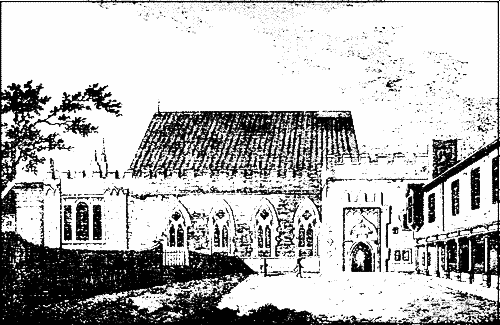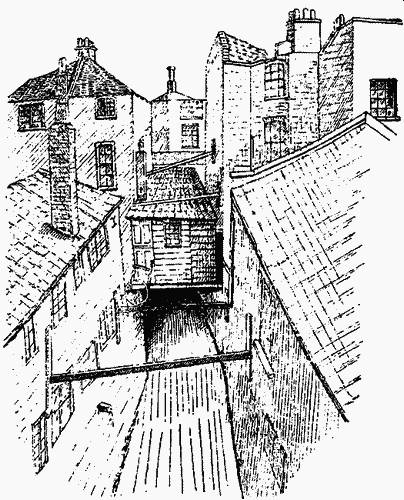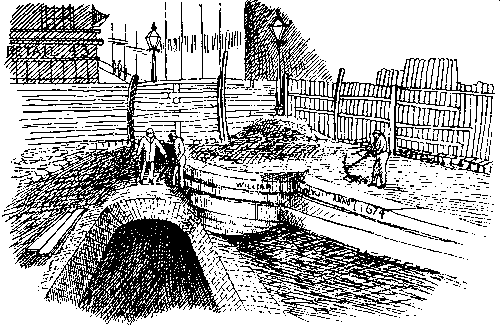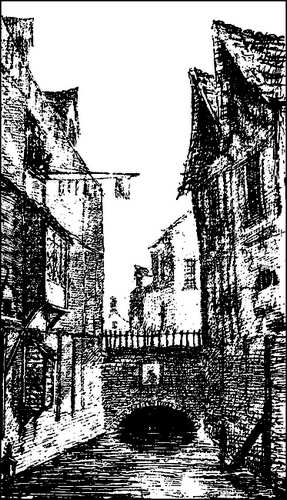

Search london history from Roman times to modern day
This London history site is a wiki of early London streets.
Close by Saffron Hill, and Fleet Lane, is Hatton Garden, or Ely Place, formerly the seats of the Bishops of Ely; which Shakespeare has made so familiar to us in _Richard III._ act iii. sc. 4. "My Lord of Ely, when I was last in Holborn, I saw good strawberries in your garden there; I do beseech you, send for some of them."[66] In Queen Elizabeth's time an arrangement was effected so that her favourite Chancellor Hatton, who "led the brawls, the Seal and Maces danc'd before him,"[67] should have this little estate, the gardens of which sloped down to the Fleet River. Hence the Bishop of Ely's place assumed the name of Hatton Garden.
There is a legend--and I give it as such--that this Sir Christopher Hatton married a beautiful gipsy girl, who bewitched him; and the price she had to pay, according to her compact with the Evil One, was her soul, and body, after a given time. When that arrived, the Devil duly came for her, and seizing her, bore her aloft, and, whilst in the air, he rent her in pieces, and threw her still palpitating heart to earth. Where it fell was, for years, known as _Bleeding Heart Yard_; but now, the authorities, whoever they may be, have altered it to _Bleeding Hart_, which, in all probability was the cognizance of the family who resided there.
This Ely Place had very extensive premises, consisting of numerous buildings, a Hall, Quadrangle, Cloisters, Chapel, a field, the historic garden, _cum multis aliis_; and they occupied a large space. Only the Chapel now remains, and that has had a curious career. At one time marriages were celebrated there, as at the Fleet, presumably that it was not under the jurisdiction of the Bishop of London, but this fiction was overruled in the case of _Barton_ v. _Wells_ in the Consistory Court, Nov. 17, 1789, when Sir Wm. Scott (afterwards Lord Stowell) decided that Ely Chapel was under the authority of the Bishop of London, and that Curates thereto must be licensed by him.
The Bishops came to London in former times, as now, and their residences, in several cases were known as _Places_, or _Palaces_. Thus, there was Winchester Place, in Southwark, now the headquarters of the Fire Brigade--formerly the palace of the Bishops of Winchester, a city which was once the metropolis of England, where Parliaments were held, and whose Bishops to this day are titular Prelates of the Garter. The Bishop of Bangor, who, although his see claims to be as old as any, has not the richest bishopric, had a palace in Shoe Lane, Holborn, and the Bishop of Lincoln also lived in Holborn.
The first mention of the connection of the Bishops of Ely, is in the will of John de Kirkeby (who was appointed Bishop in 1286), and whose will was proved in 1290, or 18 Edward I., and in the Close Roll of that year, is the following (in Latin, of course):
"_For the Executors of the Will of the Bishop of Ely._
"Whereas the King hath understood that John, late Bishop of Ely, deceased, of pious memory, hath in his last will bequeathed his houses which he had in the parish of St. Andrew near Holeburn, in the suburbs, and within the liberty of the city of London, to God, and the Church of St. Etheldreda[68] of Ely, and his successors, bishops of the same place, so that they should pay the debts which the same deceased owed for those houses to Gregory de Rokesle, the King's Citizen, of London; Ralph de Sandwich, warden of the said City, is commanded, that, without delay, he deliver the aforesaid houses, with appurtenances, which are in the King's hand and custody, by reason of the death of the aforesaid bishop, thereof to make execution of the said will.
"Witness the King at Westminster on the 18th day of July."
The next bishop--William de Luda (who must have been a person of some distinction, for he had previously held the Deanery of St. Martin's le Grand, and the Archdeaconry of Durham, besides being Chamberlain, Treasurer, and Keeper of the Wardrobe to the King) bequeathed more property to the See, and in all likelihood, built the Chapel of St. Etheldreda, which, however, was most probably considerably modified by a later Bishop, Thomas de Arundel, who held the See from 1374 to 1388--as the windows, mouldings, &c., now existing show, being about as good an example, as possible, of _Decorated_, or _Second Pointed_ architecture.
"Old _Iohn of Gaunt_, time-honoured Lancaster" lived at Ely Place for a time--in all likelihood after his palace in the Savoy, had been destroyed by rioters. This fact is noted by Shakespeare in "The life and death of King Richard the Second," act i. sc. 4:
"_Busby._ Old Iohn of Gaunt is verie sick, my Lord, Sodainly taken, and hath sent post haste To entreat your Majesty to visit him.
_Richard._ Where lyes he?
_Busby._ At Ely house."
Hollinshed, also, under date 1399, says: "In the meane time, the Duke of Lancaster departed out of this life at the Bishop of Elie's place, in Holborne, and lieth buried in the Cathedrall Church of St. Paule, in London, on the north side of the high altar, by the Ladie Blanche, his first wife."
The premises were of very great extent, as appears by plans taken before its almost total demolition in 1772. Under the Chapel was a cellar, or under croft--divided into two--and this seems to have caused some inconvenience in the seventeenth century, for Malcolm, in his "Londinium Redivivum" (vol. ii. p. 236) says: "One half of the crypt under the chapel, which had been used for interments, was then frequented as a drinking-place, where liquor was retailed; and the intoxication of the people assembled, often interrupted the offices of religion above them." And this statement seems to be borne out by a reference to Harl. MSS. 3789, _et seq._, where it says: "Even half of the vault or burying place under the Chapel is made use of as a public cellar (or was so very lately) to sell drink in, there having been frequently revellings heard there during Divine Service."
More curious things than this happened to Ely Place, for the Journals of the House of Commons inform us how, on January 3, 1642-3, "The palace was this day ordered to be converted into a prison, and John Hunt, Sergeant-at-arms, appointed keeper during the pleasure of the House." He was, at the same time, commanded to take care that the gardens, trees, chapel, and its windows, received no injury. A sufficient sum for repairs was granted from the revenues of the see.
Again, on March 1, 1660: "Ordered that it be referred to a Committee to consider how, and in what manner, the said widows, orphans, and maim'd soldiers, at Ely House, may be provided for, and paid, for the future, with the least prejudice, and most ease to the nation; and how a weekly revenue may be settled for their maintenance; and how the maimed soldiers may be disposed of, so as the nation may be eased of the charge, and how they may be provided of a preaching minister."
There were always squabbles about this property, and it nearly fell into ruin; but in 1772 an Act of Parliament was passed (Geo. III., an. 12, cap. 43) entitled "An Act for vesting _Ely House_, in _Holbourn_, in His Majesty, his Heirs and Successors, and for applying the Purchase Money, with another Sum therein mentioned, in the purchasing of a Freehold Piece of Ground in _Dover Street_, and in the building, and fitting up another House thereon, for the future Residence of the Bishops of _Ely_, and the Surplus to the Benefit of the See; and for other Purposes therein mentioned." And the town residence of the Bishop of Ely is now 37, Dover Street, Piccadilly. This little bargain was the sale to the Crown of Ely Place for L6,500, and a perpetual annuity of L200 to the Bishop of Ely and his successors.
The site and materials were purchased by a Mr. Charles Cole, an architect and builder, and he built Ely Place, Holborn. The chapel was let, and, eventually, to the Welsh Episcopalians of London. But the property got into Chancery, and the estate was ordered to be sold; and it was sold on January 28, 1874, and the chapel alone fetched L5,250. As there was no stipulation as to its purchase by any particular religious body, it was bought by the Roman Catholics, and is now St. Etheldreda's Church, Convent, and schools.

[Illustration: ELY HOUSE, 1784.]
_Apropos_ of Ely House, when Bishop Coxe demurred at surrendering the property of his see to Hatton, Queen Elizabeth wrote him that famous letter, beginning "Proud Prelate," and telling him that, if he did not do as he was told, she, who had made him what he was, could unmake him, and if he did not immediately comply, she would unfrock him--signing this very characteristic and peremptory epistle, "Yours, as you demean yourself, ELIZABETH."
On the other or east side of the Fleet was a tributary brook called Turnmill brook--a name now surviving in Turnmill Street--which, even in this century, drove flour and flatting mills, and we have indisputable evidence of its industrial powers, in an advertisement in the _Daily Courant_ September 17, 1714, which calls attention to a house in Bowling (Green) Alley,[69] Turnmill Street, which had the power of utilizing "a common sewer with a good stream, and a good current, for purposes of a Mill;" and it was on Turnmill Brook that Cave, the publisher, in 1740, went into an unprofitable partnership with one Lewis Paul, of Birmingham, to work a mill for the utilization of a patent taken out by Paul for a "Machine to spin wool or cotton into thread, yarn, or worsted." This experiment, however, was not a success.

The Fleet flowing to its bourne, the Thames, was bridged over at Holborn. Stow says: "Oldbourne bridge, over the said river of Wels more towards the north, was so called, of a bourn that sometimes ran down Oldbourne hill into the said river. This bridge of stone, like as Fleet bridge from Ludgate West, serveth for passengers with Carriage, or otherwise, from Newgate toward the west and by north." This was written in 1598.

After the great fire of 1666 the Fleet was widened, and canalized, from the Thames, to Holborn Bridge; thence, to its source, it took its natural course, and, although there were then three bridges over it, from Holborn to Newgate Street, set close, side by side, yet it was considered too narrow for the traffic, as we see in an Act of Parliament passed in 1670 (22 Car. II., cap. 11), entitled "An additional Act for the Rebuilding of the City of _London_, Uniting of Parishes, and Rebuilding of the Cathedral and Parochial Churches within the said City." Section 7 says: "And, whereas the Way or Passage of _Holborn-Bridge_ is now too strait, or incommodious for the many Carriages and Passengers daily using and frequenting the same, and is therefore necessary to be enlarged; Be it therefore likewise enacted, That it shall and may be lawful for the said Mayor, Aldermen, and Commons, so to enlarge and make wider the same, as that the said Way and Passage may run in a Bevil Line from a certain Timber house on the North side thereof, commonly called or known by the Name or Sign of the _Cock_, into the Front of the Buildings of a certain Inn called the _Swan_ Inn, situate on the North side of _Holborn Hill_, as aforesaid."
Sir Christopher Wren built this bridge, which was meant to be the ornamental end of "The New Canal," as it is described in the map of Farringdon Ward in Stow's "Survey" (ed. 1720). It must have taken some time to complete, for it was not finished until the Mayoralty of Sir William Hooker, whose name appeared carved upon it (although somewhat mutilated) when it was uncovered in March, 1840. Sir William Tite, C.B., M.P., F.S.A., &c., Architect to the City of London, writing at that date, says: "The Sewer at Holborn Hill was opened, and as I was passing, I saw the southern face of the Bridge which crossed the Fleet at this place uncovered to some extent. It was built of red brick, and the arch was about twenty feet span. The road from the east intersected the bridge obliquely, which irregularity was obviated from a moulded and well-executed stone corbel arising out of the angle thus formed, which carried the parapet. On the plinth course of the parapet was cut the inscription following, recording the fact of the erection of the bridge, with the name of the Lord Mayor at the period:--"William Hooke(r). (A)nno D. 1674."
Sir William Tite says it was a red brick bridge; Hatton, in his "New View of London" (1708), says it was of stone; but then, probably, he never really saw it, and Tite did. Hatton's description is: "_Holbourn Bridge_ is built of Stone, it leads from _Holbourn_ to _Snow Hill_, over the N. end of the _Fleet Brook_, where a little rivulet called _Wells_, falls by _Hockley Hole_, running a little E'd of _Saffron Hill_, crossing near the W. end of _Chick Lane_, and so into this Brook."
The canalization of the Fleet after 1666 was a useful work, as it enabled barges to go up to Holborn Bridge; and that it was availed of, we can judge by the frontispiece, which was painted in the middle of the eighteenth century; but it was not much used, if we can trust Ned Ward, whose sharp eyes looked everywhere, and whose pen recorded his scrutiny[71]: "From thence we took a turn down by the Ditch side, I desiring my Friend to inform me what great Advantages this costly Brook contributed to the Town, to Countervail the Expence of Seventy four Thousand Pounds, which I read in a very Credible Author, was the Charge of its making: He told me he was wholly unacquainted with any, unless it was now and then to bring up a few Chaldron of Coles to two or three Pedling _Fewel-Marchants_, who sell them never the Cheaper to the Poor for such a Conveniency: and, as for those Cellars you see on each side design'd for Ware-Houses, they are render'd by their dampness so unfit for that purpose that they are wholly useless, except... or to harbour Frogs, Toads, and other Vermin. The greatest good that ever I heard it did was to the Undertaker, who is bound to acknowledge he has found better Fishing in that muddy Stream, than ever he did in clear Water."

[Illustration: END OF HOLBORN BRIDGE, TAKEN FROM THE SOUTH, AND PART OF HOLBORN HILL. JUNE 2, 1840. (_Art. Crosby._)]
Gay, too, in his "Trivia," more than once mentions the foulness of the Fleet in book ii.
"Or who that rugged street[72] would traverse o'er, That stretches, O Fleet-Ditch, from thy black shore To the Tour's moated walls?"
And again:
"If where Fleet-Ditch with muddy current flows."
Here is a pen-and-ink sketch of Holborn Bridge--from some old engraving or painting (Crosby does not give his authority), which gives an excellent idea of old London--squalid and filthy according to our ideas. How different from that noble viaduct which now spans the course of the Fleet River! which her Majesty opened on November 6, 1869.

[Illustration: HOLBORN BRIDGE.]
Trying to avoid privacy and cookie settings overwriting content